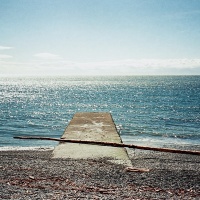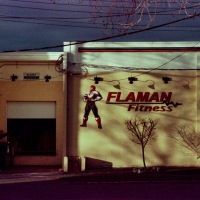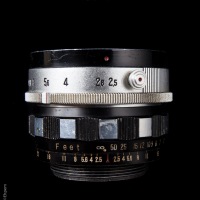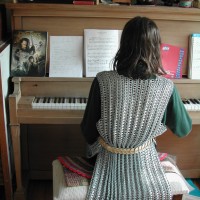Boat Shed Star Trails
 We spent Canadian Thanksgiving two weeks ago with friends on Read Island. It is located near Campbell River between Vancouver Island and the mainland. Before we left my blogging friend Melinda (One Day | One Image) suggested I try some star trail photos seeing as how we would be away from light pollution. She kindly sent me a couple of her shots as inspiration, and some how-to links. I did not get a chance to look at the links, but should have.
We spent Canadian Thanksgiving two weeks ago with friends on Read Island. It is located near Campbell River between Vancouver Island and the mainland. Before we left my blogging friend Melinda (One Day | One Image) suggested I try some star trail photos seeing as how we would be away from light pollution. She kindly sent me a couple of her shots as inspiration, and some how-to links. I did not get a chance to look at the links, but should have.
I was convinced to take my tripod, even though clear nights seemed unlikely and it was an extra bother since the trip ends with travel in a small boat (after a bit less than 4 hours driving, a ferry to Quadra Island and another 45 minutes in the car). In any case, this is one of the shots I took. It is a single exposure taken, so the EXIF data says, with a 4,435 second exposure (which is 73.92 minutes). Thanks to some software rescue and a very good sensor, it worked out OK, but nearly was a bust.
At first my shots were much shorter exposures, but I wanted the longer star trails which I suppose people usually obtain by stacking a number of photos. In one of the first photos I managed to find the North Star, so that view became the focus of a second much longer exposure the next night. The earlier shots looked pretty good on the camera screen so I was content to carry on in this way. However, there were many difficulties.
The structure is called a boat shed by my friends, but really it is not for boats. Below here is the dock, and the shot is taken from a turn in the ramp down to the dock, probably about 10 feet above the water. There are no handrails, no lights and very little room to move. I chose this spot because it has a concrete pad where the two ramps join. I could get two tripod legs on concrete, and a third on a rough spot in the cliff beside the ramp, thus preventing camera shake from ramp movement. I had found it a bit spooky on the first night sitting in the dark on a ledge on the bedrock, feet on the ramp, for 10 and 20 minute exposures. After a while I could hear every little snap and slither in the forest behind me, I swear I could even hear springtails breathing in the litter-mat. Soil dwellers are fine by me, but since there are cougars, wolves and bears in that forest my eyes got quite large while I sat there back to the forest. You know how it works, the larger you open your eyes, the better you can hear, right? Besides imagined fangs, it became kind of boring after an hour or so.
So, for this exposure I decided to just let it run by itself and hope no large animals (including humans and dogs) would knock the camera into the ocean. I went back to the cabin and drank some single malt while the camera gathered what little light there was. The exposure looked great in camera and I was pretty pleased with myself, never having taken star trail shots before. Pleased until I got the photo home and looked at it on the computer screen. Man, was it noisy. Incredibly so. And why did I expect otherwise? Inexperience, and nothing more. Below is a ~1:1 out-of-camera crop so you can see what I mean.

.
I am glad I remembered that I have a copy of Topaz DeNoise, never used, downloaded as part of a bundle I bought a few months ago. After doing some not very successful noise reduction in LR4, I ran it through the Topaz plug-in, to satisfactory effect, though at a cost to detail. Below is a similar crop from post-Topaz processed image at the top of this post. It makes for a useable image, though not one I would want to blow up very large. I had a bit of a go at cloning out some hot pixels and other spots in Lightroom after the Topaz processing, to clean things up a bit more, but very little. I tried to straighten the shot (I should have used a level on the camera…) but I lost too many bits of the photo that I like, so I left it with the original angle intact.

I am glad to have salvaged this image – it was a fun weekend and so it is nice to have this memory to go with it. As it happened by pure fluke my job (the one I am about to ‘retire’ from) took me up to this area the following friday and so I took the opportunity and spent last weekend there as well, helping with the initial stage of a research project I will be part of in the coming months. Not a bad spot to be doing field work. You are likely to see a lot more from this part of the world next year.
.
Canon 5Dii, Nikkor-N 24mm/f2.8 lens, ISO100, f11, 74 minute exposure (picture below – Canon G15, 30mm, ISO200, f8, 1/200th).

- Essential gear for long exposure photography
.












Pingback: North Star Trails - Photomiser: Budget Photography
Pingback: Anniversary Links | burnt embers
Pingback: Boatshed Sunset | burnt embers
Pingback: Foggy Sunset | burnt embers
Interesting explanation of your struggles with night photography and a good image as a result; but the best one was the Single Malt 🙂 I agree, never go on a photographic trip without some. Can’t beat those smoky malts for a bit of warmth.
David.
LikeLike
Ha! I agree, the smoky ones are the way to go.
LikeLike
Love the star trails, and yes, you found the essential gear for long exposures 🙂
LikeLike
Thank you Lynn – sometimes one stumbles on these secrets of the hoary old photographer and wonders why they aren’t shared. I like sharing though, so now all my readers know!
LikeLike
Star trails are an exciting project. I have never tried myself so I can only imagine how thrilled you were at your first time result. I have used that Topaz plug-in many times for some noisy concert shots and it’s a lifesaver. You can only go so far in LR and then you need to bring out the big guns. My “essential gear” would problably include some bug spray, too.
LikeLike
Thanks Ken. Lifesaver for sure. I am pretty impressed with how it all worked out, though there is much loss in the image quality so it is a pretty big compromise.
Bug spray is not much needed right on the water’s edge in this part of the world even at the height of the seaso. At this time of year it’s not needed at all, anywhere. Last weekend I spent quite a lot of time coring bog and small lakes in this area for paleoenvironmental samples and not a single bug was seen. Which begs the question, why is such work ever done in the summer?
LikeLike
We had a hard frost the other day and most of the bugs are gone now, making my hikes much more pleasurable and with no bug spray. So far, a light jacket is all that’s needed but soon the parkas, hats and gloves will have to come out of storage.
LikeLike
I realized, when I read all the way to the end, that I am sadly lacking in the “essential gear” that you mentioned.
I am glad you hauled your tripod along on your trip – and also glad the cougars weren’t hungry while you were there!
LikeLike
Hi Melinda – thanks for the idea! I probably would have left the tripod at home, though I also had the idea of taking some long exposures of water, which I did not get around to. Hungry cougars are a bit worrying – I feel pretty comfortable around the coastal black bears and wolves I have only come across a couple of times. Cougars you just don’t see, and if you do, then likely it means trouble.
LikeLike
A very worthwhile experiment and fascinating results. Glad to see you chose my favourite Islay malt as an accompaniment.
LikeLike
Hi Patrick – thanks, it did work out in the end. It is much more subtle than the photo stacking method which gets brighter stars and trails. I think I like it this way better, though perhaps that is also a function of the f-stop. That *is* a very nice malt – more subtle than many. It does not seem so much like there is a cube of scorched peat somewhere in the bottle, just a few sticks from the peat.
LikeLike